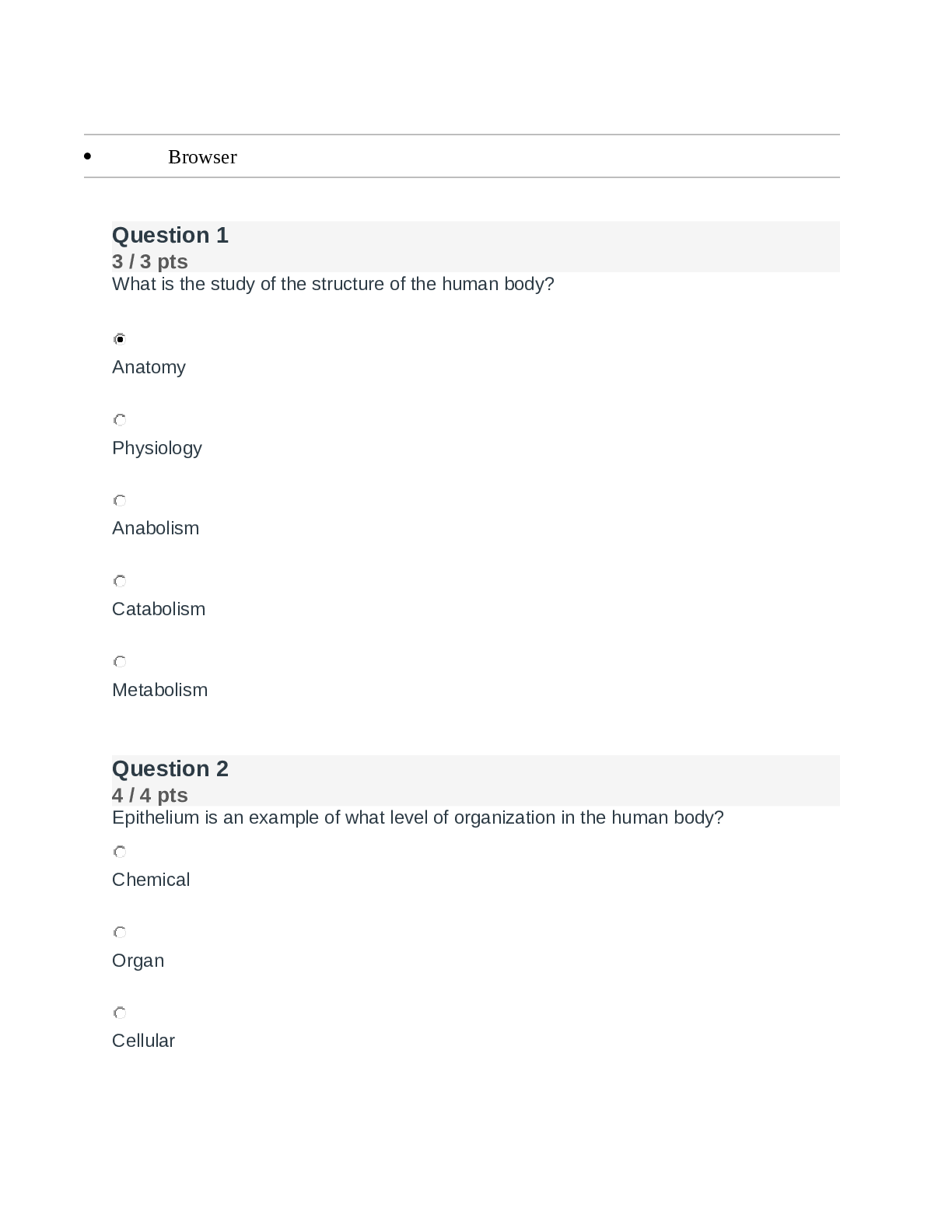*NURSING > Final Exam Review > NURS 6512 Final Exam Review (WEEK 7-11) Heart, Lungs, and Peripheral Vascular Examination Techniques (All)
NURS 6512 Final Exam Review (WEEK 7-11) Heart, Lungs, and Peripheral Vascular Examination Techniques Of The Heart, Lungs, and PV systems |LATEST UPDATED VERSION
Document Content and Description Below
NURS 6512 Final Exam Review (Week 7-11) Heart, Lungs, and Peripheral Vascular Examination techniques of the Heart, Lungs, and PV systems 1. Examination techniques of the Heart : Inspectio... n - use tangential lighting; stand to the patient’s right, patient should sit erect and lean forward, lye supine, and left lateral recumbent position; apical pulse midclavicular line 5th left intercostal space; check the skin for cyanosis, venous distention, nail bed for cyanosis and capillary refill time Palpation - patient supine, palpate the precordium, use proximal halves of the 4 fingers or whole hand; being at apex, move inferior to left sternal border, then up the sternum to the base and down the right sternal border in the epigastrium or axillae; apical pulse seen at point of maximal impulse; feel for a thrill – fine, palpable, rushing, vibration, a palpable murmur, over the base of the heart; locate each sensation in terms of its intercostal space and relationship to the midsternal, midclavicular, or axillary lines; when palpating the precordium, use your other hand to palpate the carotid artery Percussion - limited value by defining the borders of the heart or determining its size because the shape of the chest is rigid; a chest radiograph useful in defining the heart border; begin tapping at the anterior axillary line, moving medially along the intercostal spaces toward the sternal border; resonant to dull marks the border; Auscultation - listen to all 5 of the cardiac areas using the diaphragm first then the bell; use firm pressure with the diaphragm and light pressure with the bell; 5 cardiac areas – aortic valve, pulmonic valve, second pulmonic, tricuspid, mitral; assess rate and rhythm, have patient breath normally then hold the breath in expiration, listen for S1 while palpating the carotid pulse; have the patient inhale deeply, listen closely for S2 during inspiration; basic heart sounds pitch, intensity, duration, and timing in the cardiac cycle; 4 basic heart sounds S1, S2, S3, S4 1. Examination techniques of the lungs: Chest/Lungs – Inspect the chest, front, back, noting thoracic landmarks of and shape of anteroposterior (AP) diameter compared with the lateral diameter, symmetry, color, superficial venous patterns, prominence of ribs Inspection; patient sit upright, unclothed, using tangential light Retractions and deformity e.g. minimal pectus excavatum are difficult to detect; pigeon chest, funnel chest, barrel chest seen with chronic condition AP diameter less than lateral diameter; if they equal each other, chronic condition present – e.g. barrel chest related to chronic asthma, emphysema Evaluate respirations for rate and rhythm – respiratory rate is 12-20 per minute; respirations to heartbeats is a 1:4 ratio; Rhythm – breathe easily, regularly, with no apparent distress; variations – to shallow or to deep; tachypnea – rapid breathing, Kussmal – deep and rapid, Cheyene-Stokes – regular periods of breathing with intervals of apnea followed by a crescendo/decrescendo sequence of respiration Inspect chest movement with breathing for symmetry and use of accessory muscles; retractions are seen when the chest wall seems to cave in at the sternum Palpate the chest for thoracic expansion, sensations such as crepitus (palpated and heard) - gently bubbling feeling, grating vibrations, Tactile fremitus (palpable vibration of the chest wall that occurs from speech), best felt posteriorly, use phrase “99” or “Mickey Mouse”, palpate both sides simultaneously and symmetrically; increased fremitus fluid or solid mass is present, decreased is excess air in the lungs Thoracic expansion evaluation – stand behind patient, place thumbs along spinal process of the tenth rib with palms lightly in contact with posterolateral surfaces, thumbs will diverge during quiet and deep breathing Palpate for pulsations, tenderness, bulges, depressions, masses, and unusual movement Pleural friction rub – grating, coarse vibration, on inspiration, e.g. leather rubbing on leather Perform direct or indirect percussion of the chest, comparing both sides for diaphragmatic excursion, percussion tone intensity, pitch, duration, and quality - tap sharply and consistently from the wrist; examine back of patient while sitting with the head bent forward and arms folded in front, then have patient raise arms overhead while percussing the later and anterior chest Resonance heard over all areas of the lungs, hyperreasonance heard with hyperinflation (emphysema, asthma), dullness or flatness suggests pneumonia or atelectasis Diaphragmatic excursion – the movement of the thoracic diaphragm during inhalation and exhalation; pg. 274 Dains – pt. Take breath, hold it, percuss scapular line locating lower border, mark the point where resonance changes to dullness, mark with a marking pen, allow the patient to breathe, then repeat the procedure on the other side, have the patient take several breaths to exhale as much as possible and then to hold; percuss up from the marked point and make a mark at the change from dullness to resonance, have the patient start to breathe and then repeat on the other side; measure and record the distance in cm between the marks on each side, distance is usually 3-5 cm Auscultate the chest with the stethoscope diaphragm, from apex to base, comparing both sides for intensity, pitch, duration, quality of breath sounds, unexpected breath sounds (crackles, rhonchi, wheezes, friction rubs) and vocal resonance; have pt. Sit up and breathe slowly and deeply through the mouth; have the patient sit the same way as for percussion; also have the patient sit erect with shoulder back for auscultation of the anterior chest Breath sounds – vesicular, bronchovesicular and bronchial pg. 276; adventitious breath sounds – crackles (formerly rales), rhonchi, wheezes, friction rub Vocal resonance – spoken voice transmits through the lung fields that may be heard with the stethoscope, have patient recited numbers, names and other words Examination techniques of the peripheral vascular system: Peripheral Arteries – palpation occurs best over the arteries, close to the surface, that lie over bones; when palpating the carotid, never palpate both sides simultaneously; palpate at least one pulse point in each extremity, usually at the most distal point; perform the Allen test (pg. 340) to ensure ulnar artery patency prior to radial artery puncture; the thumb can be used to fix the brachial or femoral pulse; palpate the arterial pulses to assess heart rate, rhythm, pulse controu, amplitude, symmetry, and occasiuonally sometimes obstructions to blood flow Carotid, brachial, radial, femoral, popliteal, dorsalis pedis, and posterior tibial arteries Observe for signs of cyanosis, lip pursing, finger clubbing, alae nasi for flaring – any signs of this suggest cardiac or respiratory difficulty Alae nasi flaring – sign of air hunger Clubbing – enlargement of the terminal phalanges of the fingers/and or toes; seen with emphysema, lung cancer, cystic fibrosis, congenital heart disease Auscultation – use the bell of the stethoscope over the artery, auscultate for a bruit over the carotid, subclavian, abdominal aorta, renal, iliac, and femoral arteries; when listening to the carotid, have the patient suspend their breathing for a few seconds; assess the degree of peripheral artery degree – patient lie supine, elevate extremity, note degree of blanching, have patient sit on edge of bed to lower the extremity, note time for return of color to extremity; assess capillary refill; jugular venous pressure – pg.342. Assess Homan sign, edema, and varicose veins Examination findings of arterial blood flow in infants Examination findings of arterial blood flow in infants - arterial blood flow in infants; after the umbilical chord is cut, blood flows to the lungs at a higher pace, pulmonary arteries expand and relax which decreases the resistance of systemic circulation; the decrease leads to closure of the foramen ovale shortly after birth, increased oxygen tension in the arterial blood usually stimulates contraction and closure of the ductus arteriosus Examination findings of the heart and lungs in a patient with illegal drug use Examination findings of the heart and lungs in a patient with illegal drug use - severe chest pain associated with cocaine use, tachycardia, hypertension, coronary arterial spasm and pneumothorax with acute chest pain are symptoms Description of types of shortness of breath (orthopnea, platypnea. Tachypnea, bradypnea) Description of types of shortness of breath * Orthopnea: Shortness of breath that begins or increases when the patient lies down. Ask whether the patient need to sleep on more than one pillow and whether it helps * Platypnea: Dyspnea increases in the upright position * Tachypnea: Faster than 20 breaths per min. Rapid breathing with no change in depth, and can be caused by hypoxia, pain, fever, or anxiety. Consider PE, foreign body aspiration, anaphylaxis, pneumothorax, heart failure, asthma, or pneumonia * Bradypnea: Slower than 20 breaths per minutes Symptoms associated with intrathoracic infection Symptoms associated with intrathoracic infection * Dyspnea * tachypnea * Pleuritic chest pain * Fever * Cough with green/rusty sputum [Show More]
Last updated: 1 year ago
Preview 1 out of 52 pages
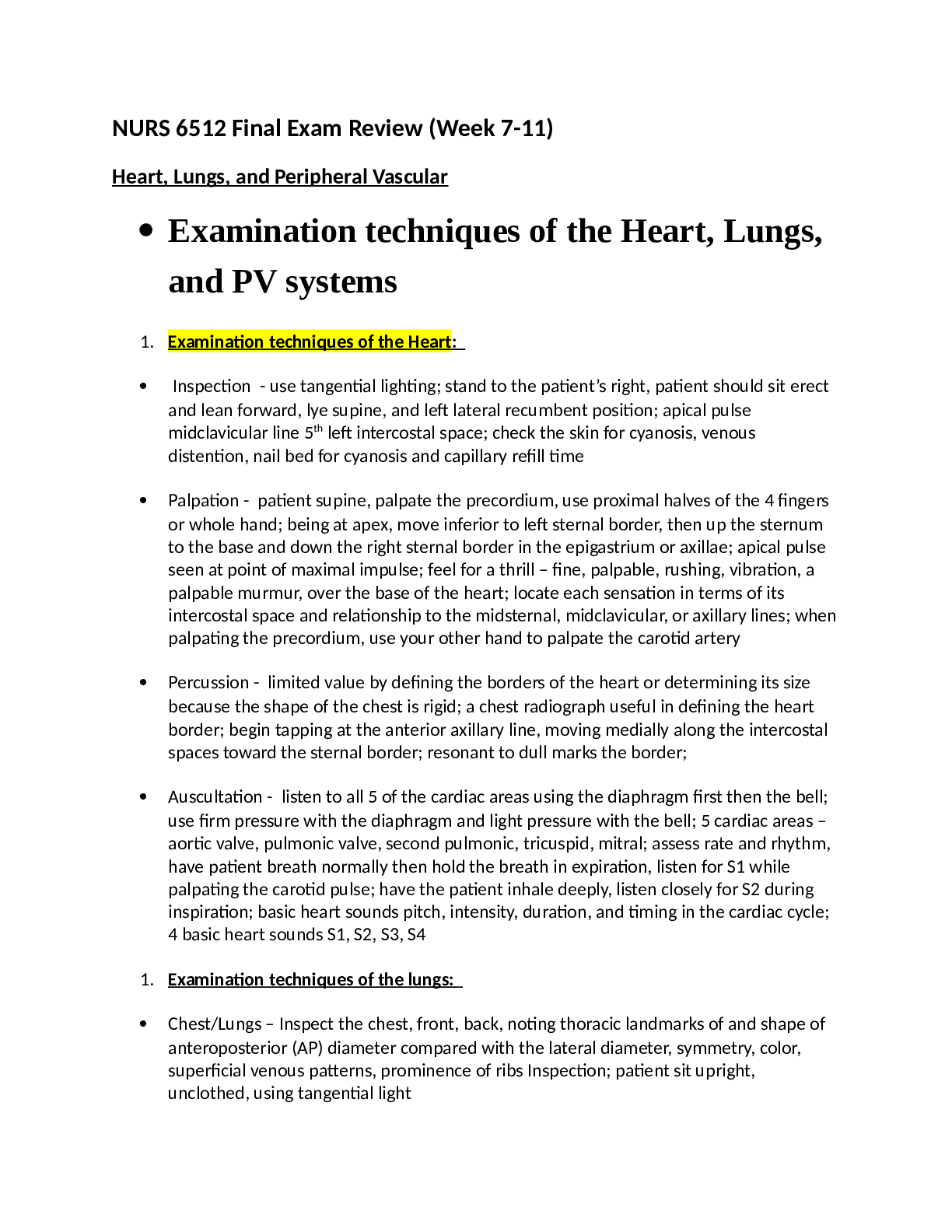
Reviews( 0 )
Document information
Connected school, study & course
About the document
Uploaded On
Nov 21, 2021
Number of pages
52
Written in
Additional information
This document has been written for:
Uploaded
Nov 21, 2021
Downloads
0
Views
124

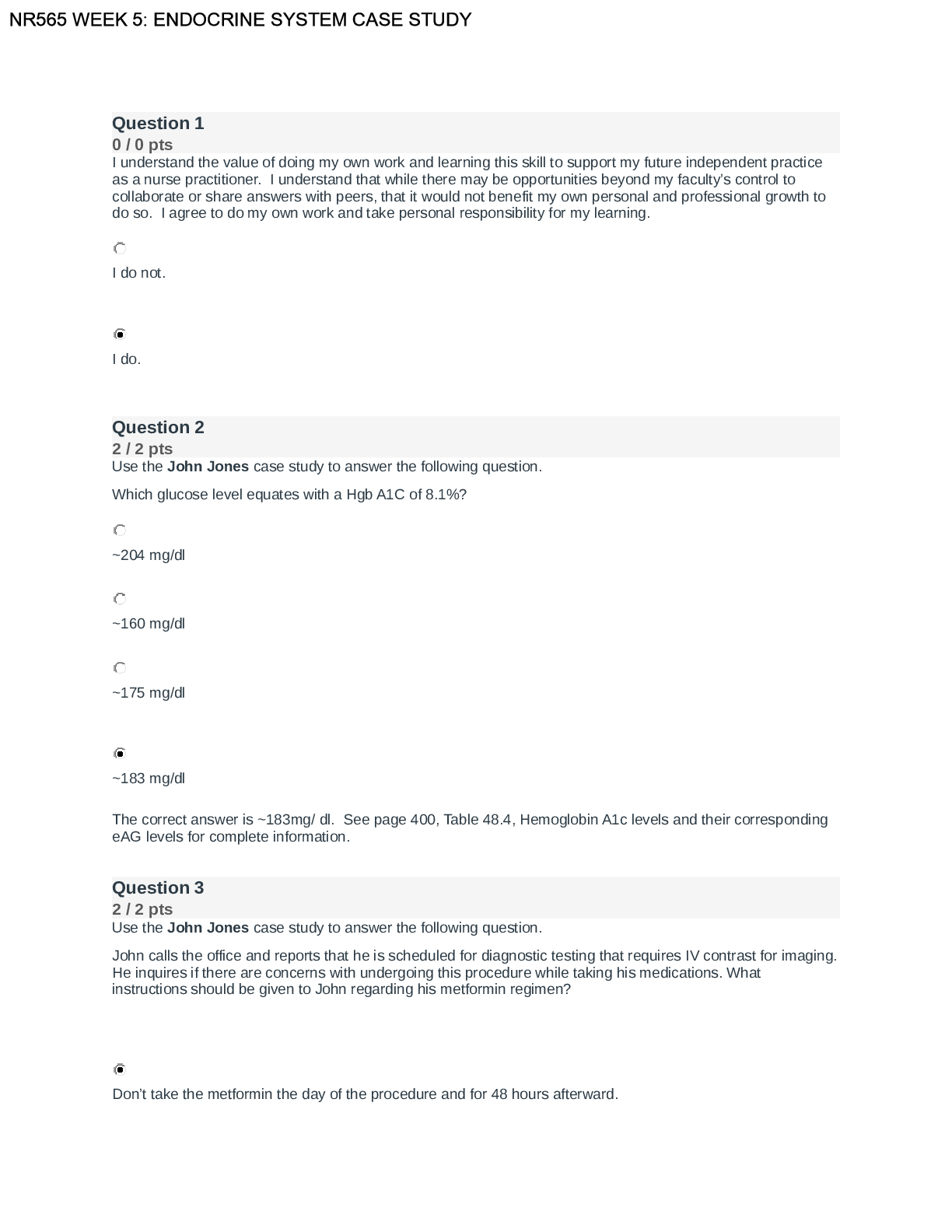
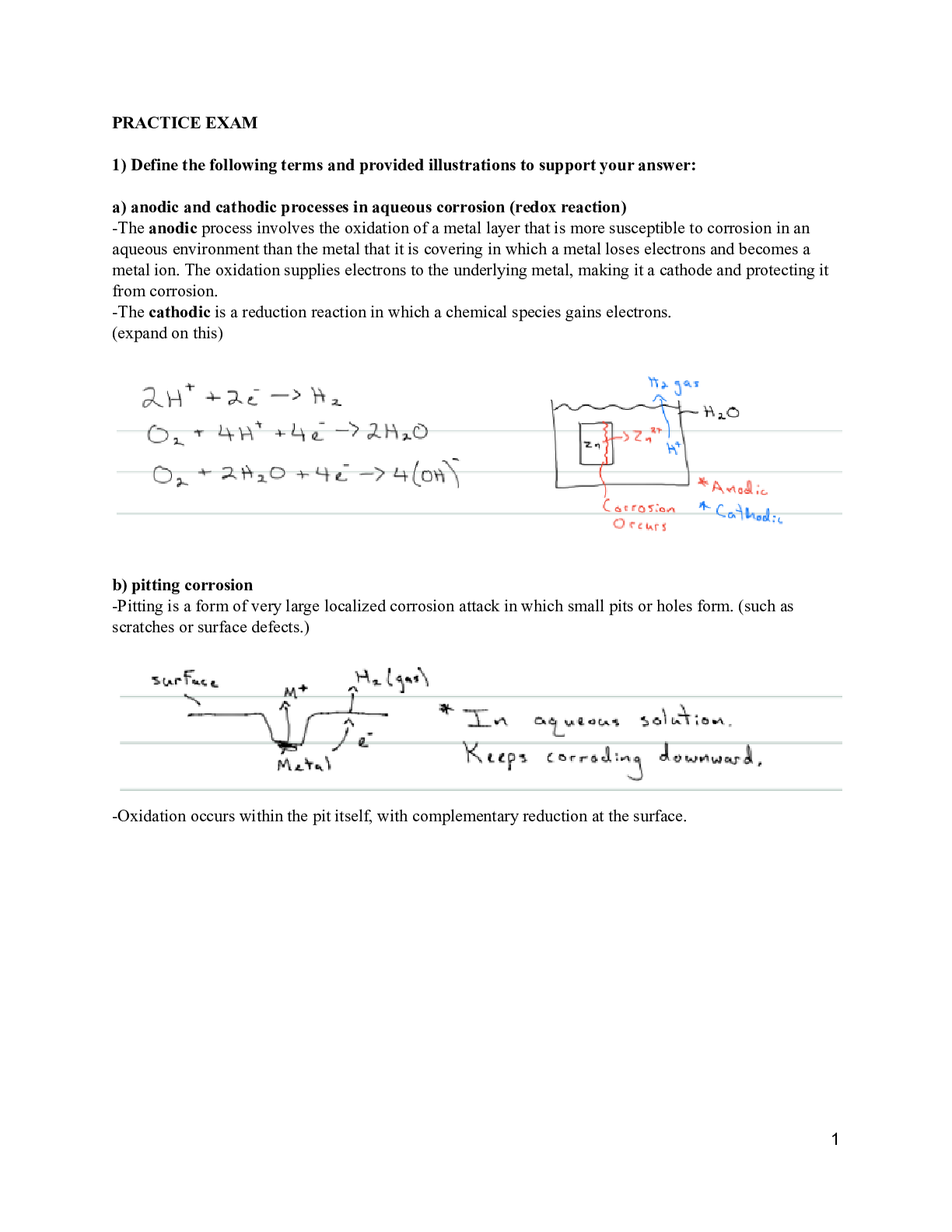
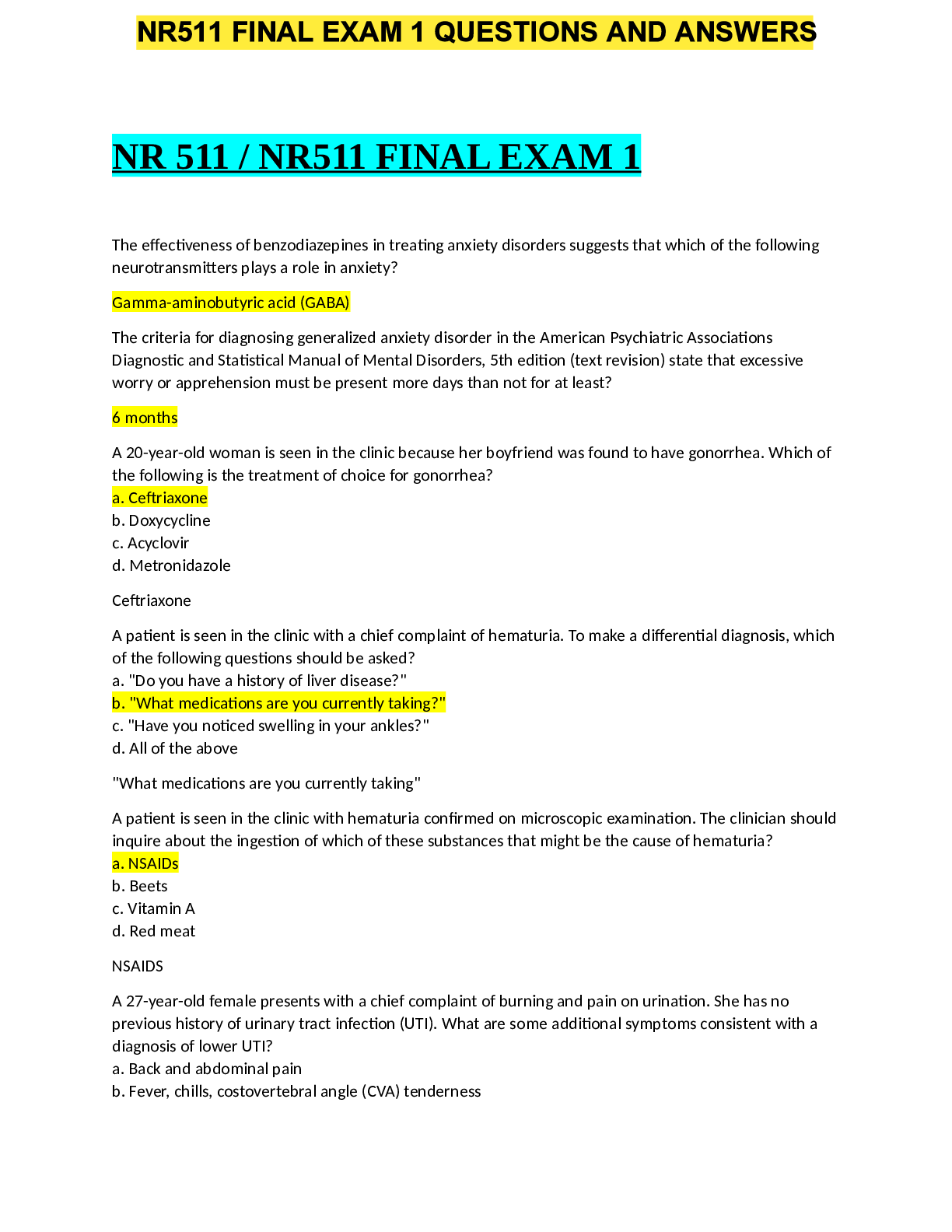
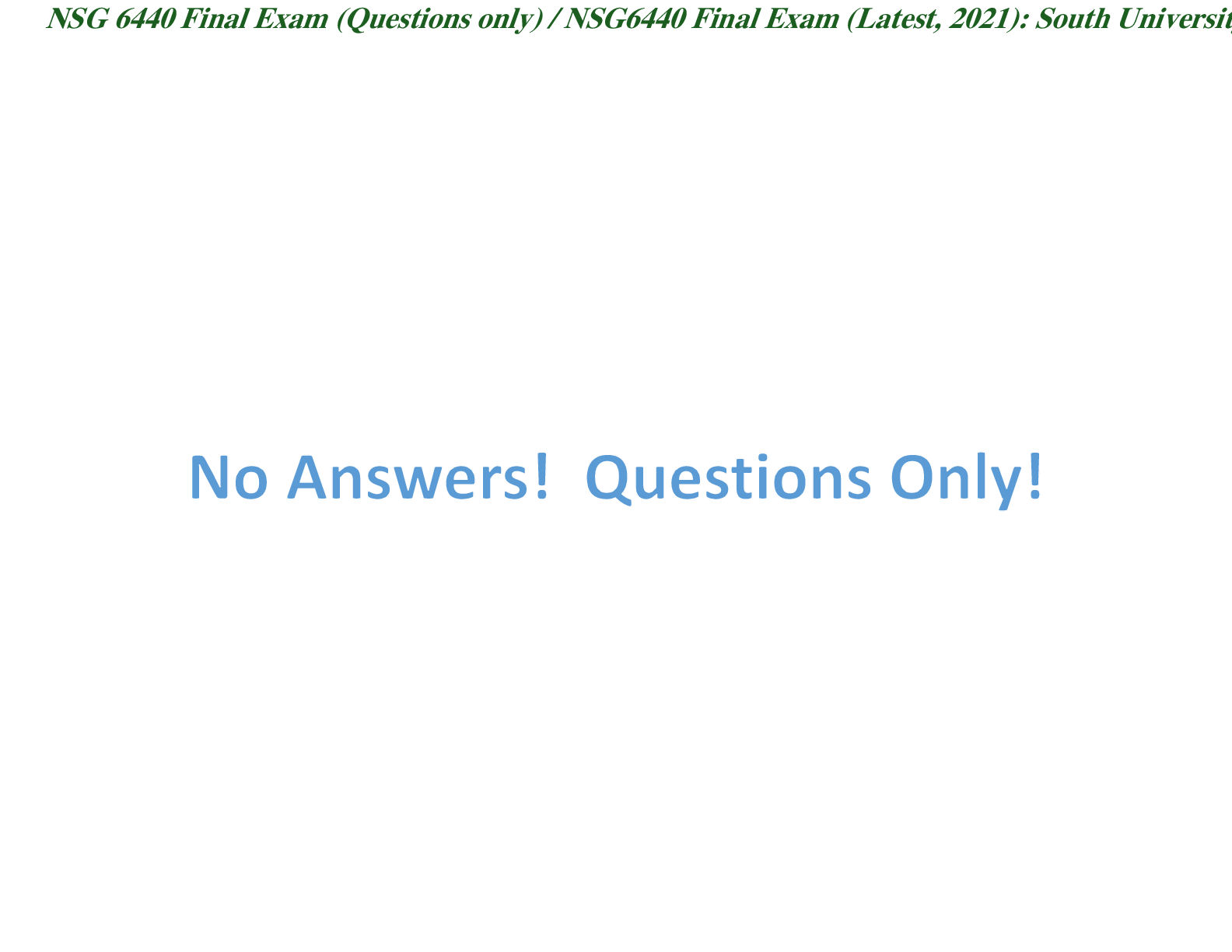
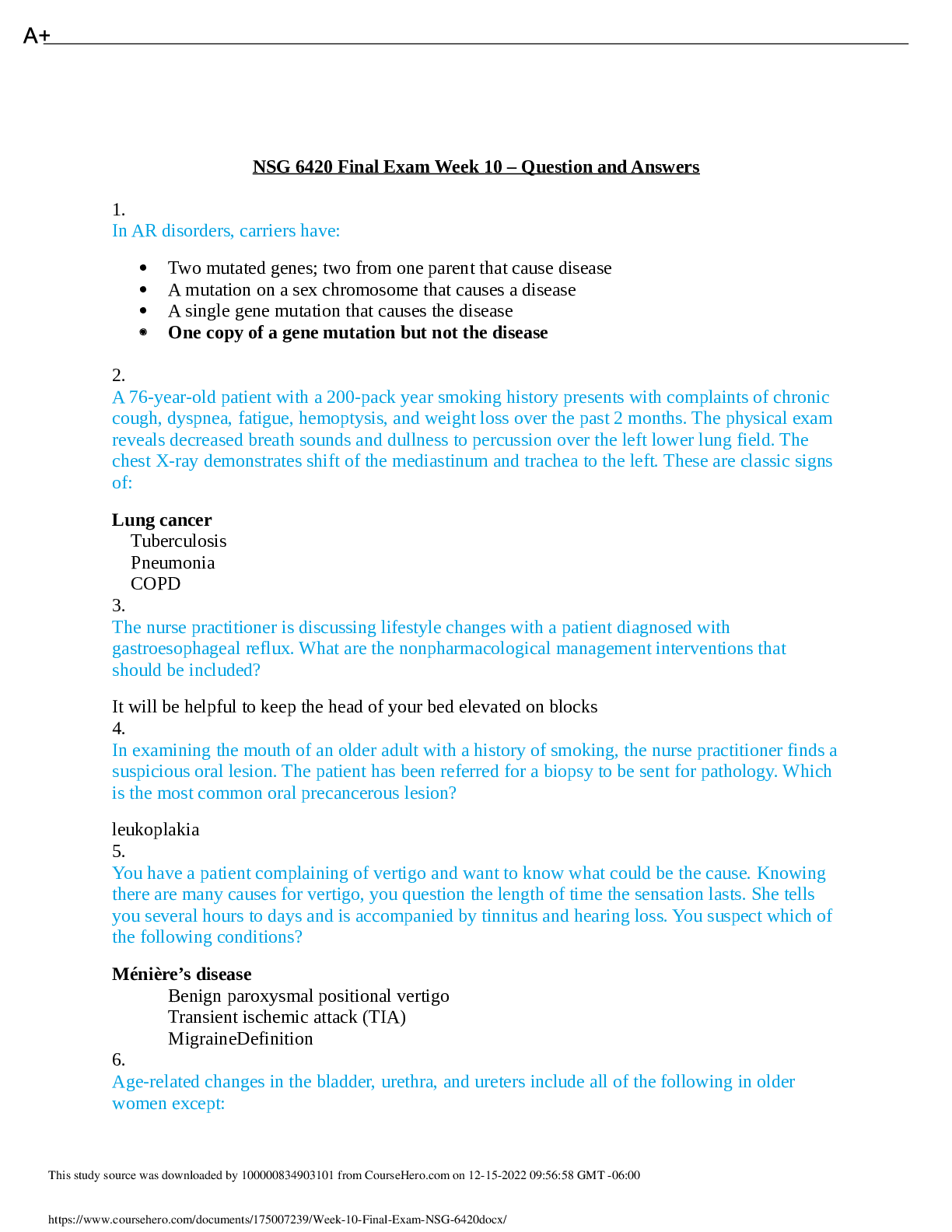

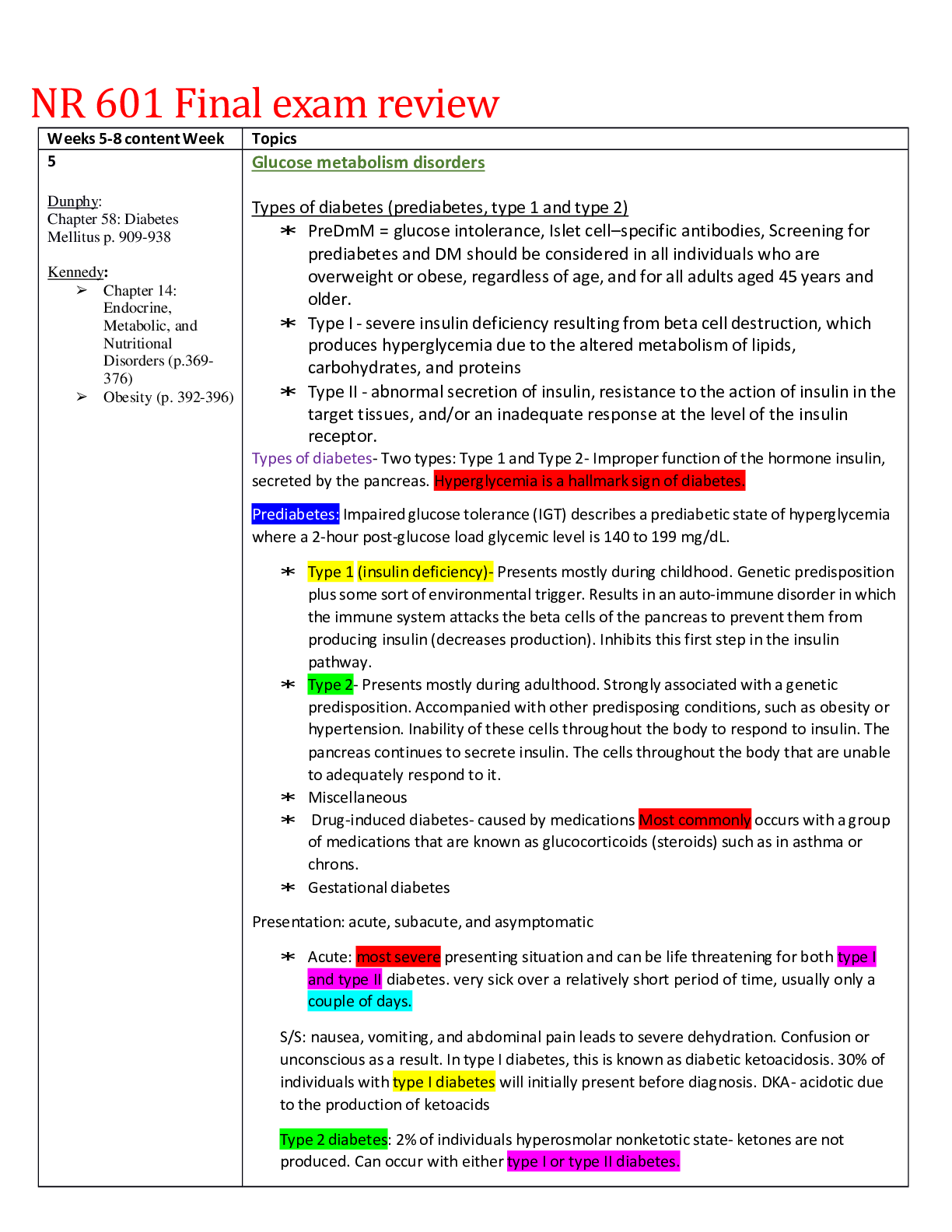
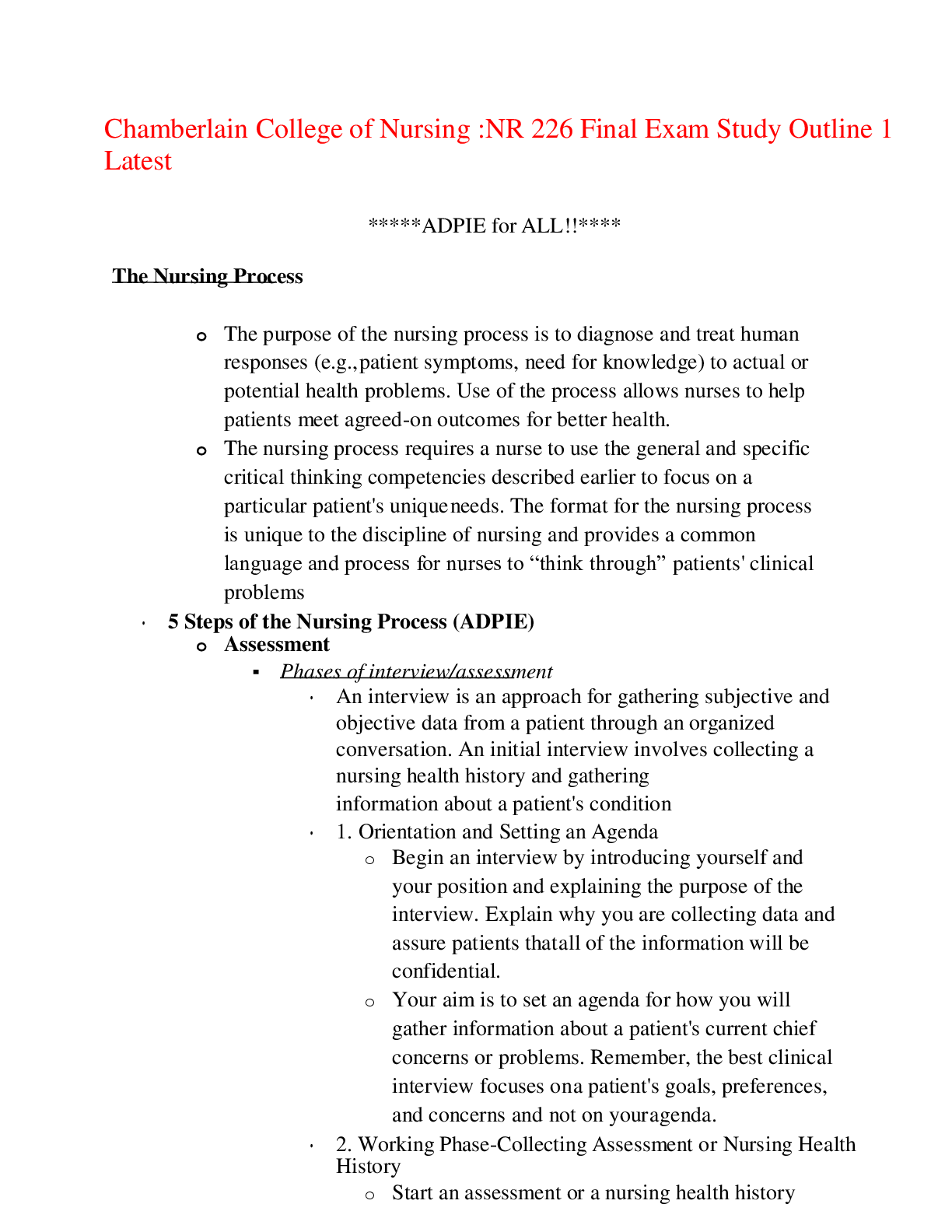
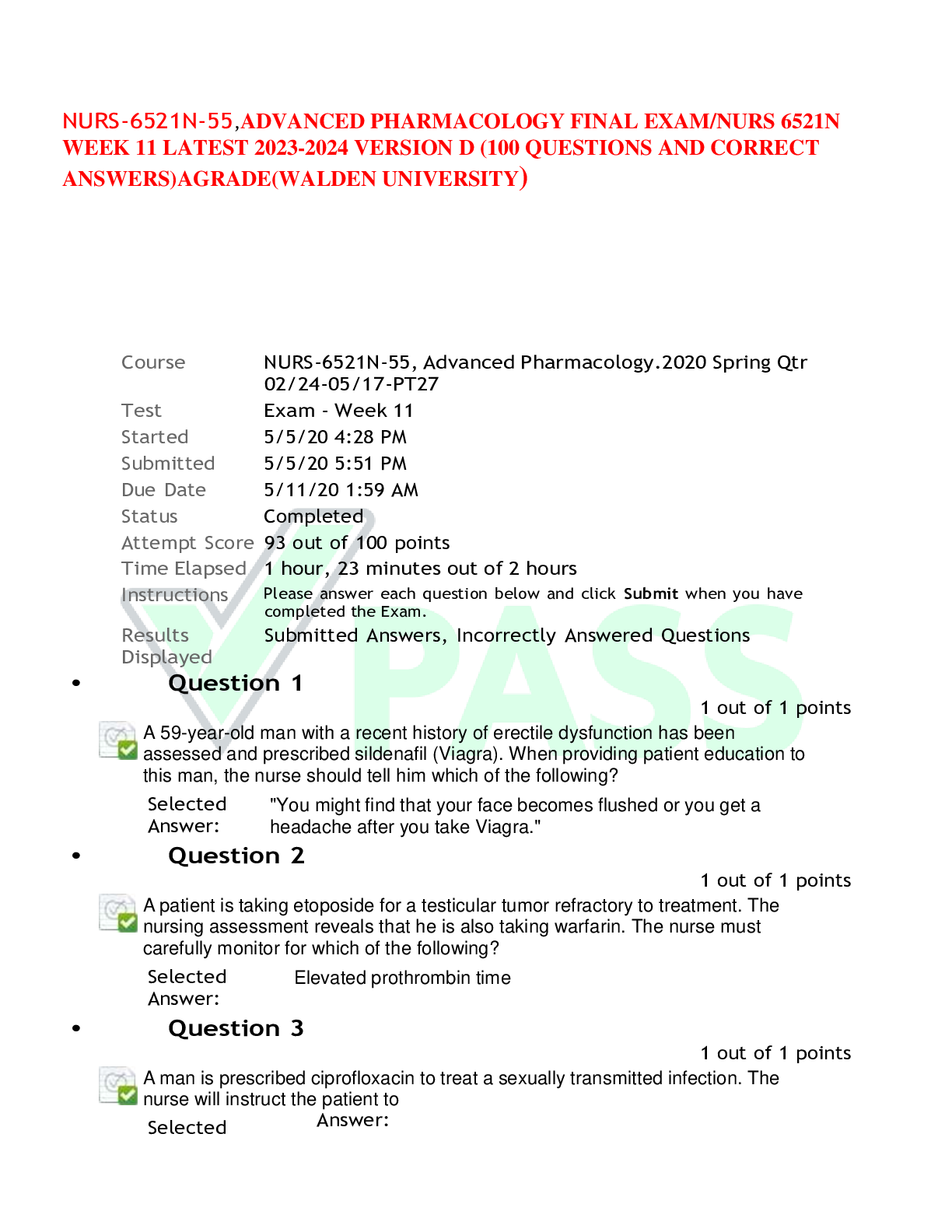

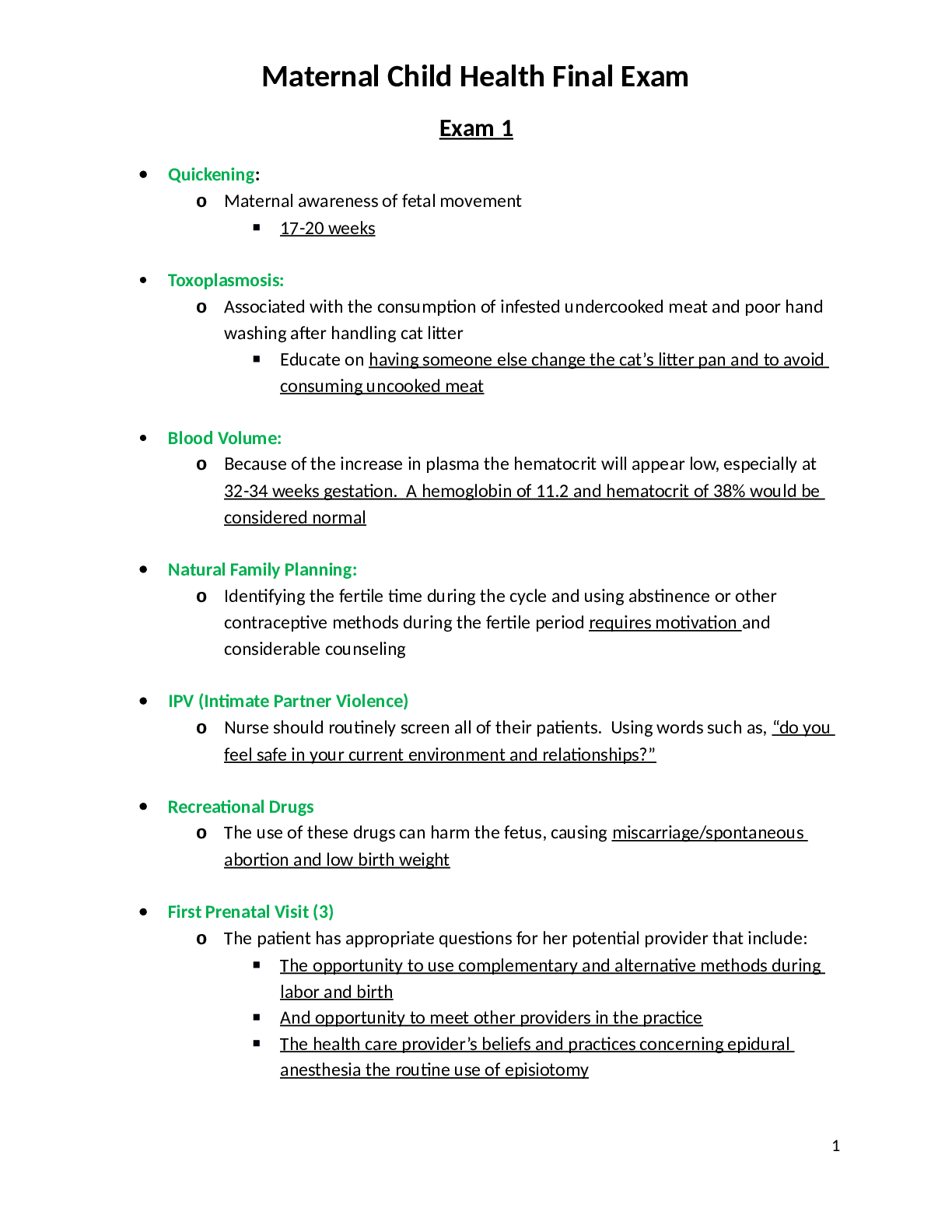

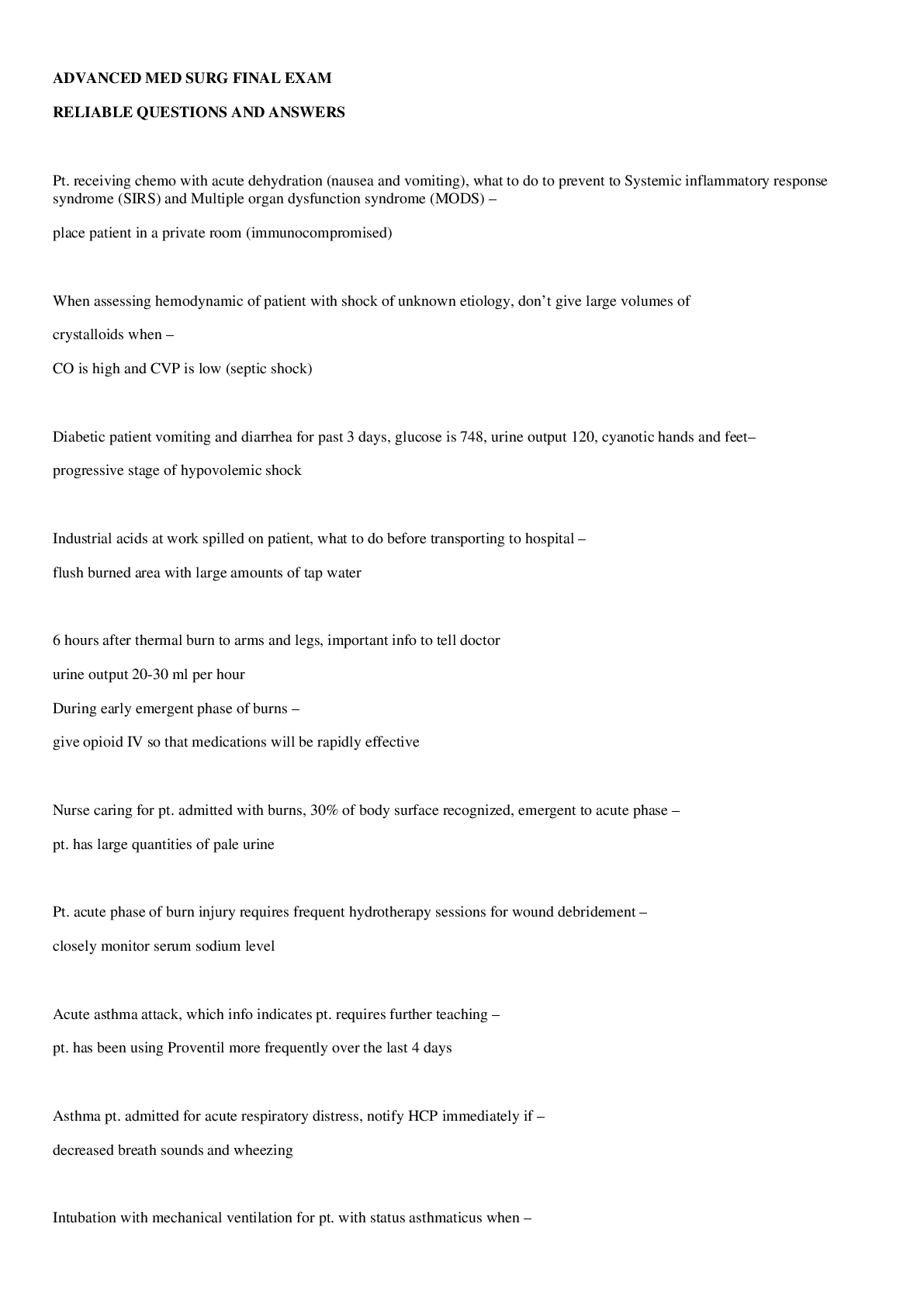
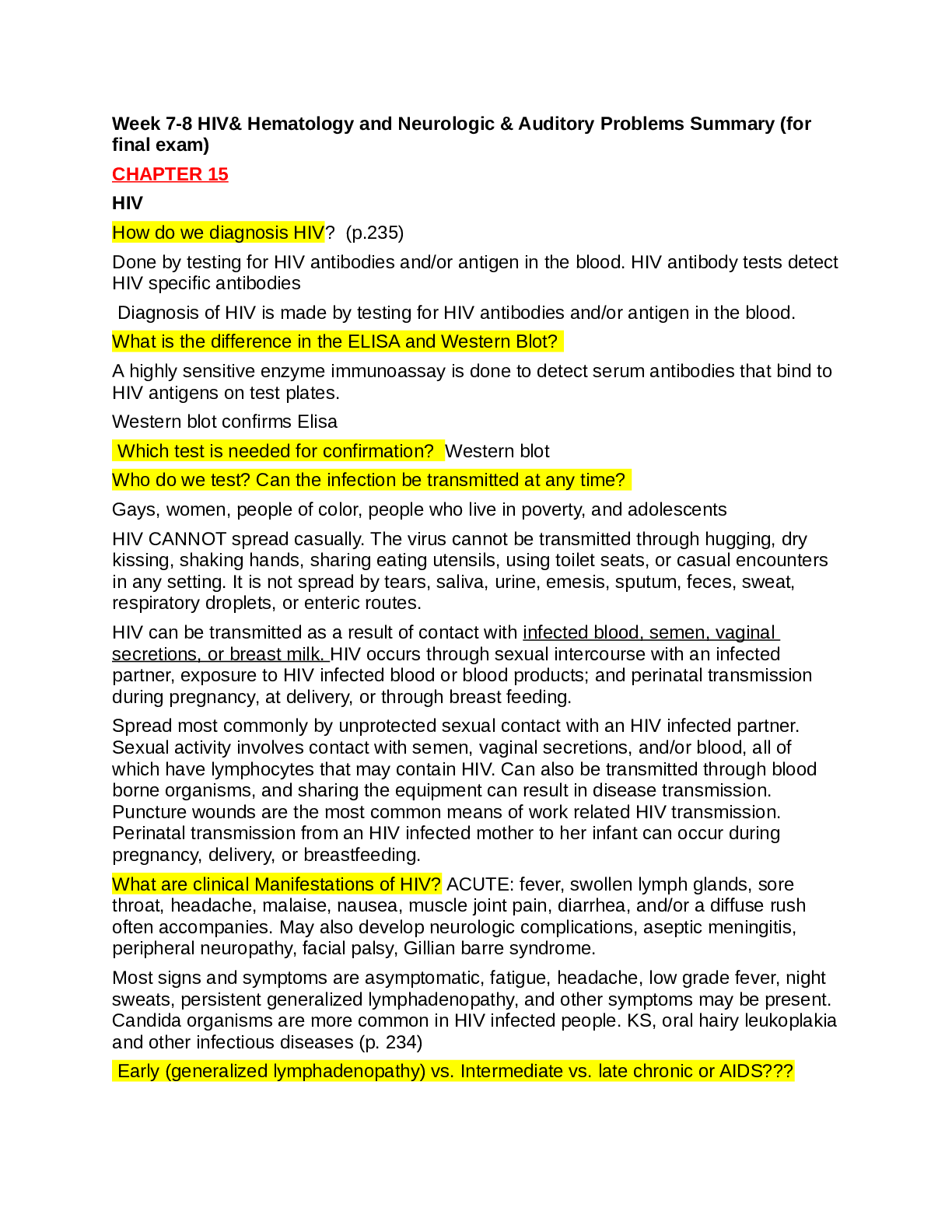
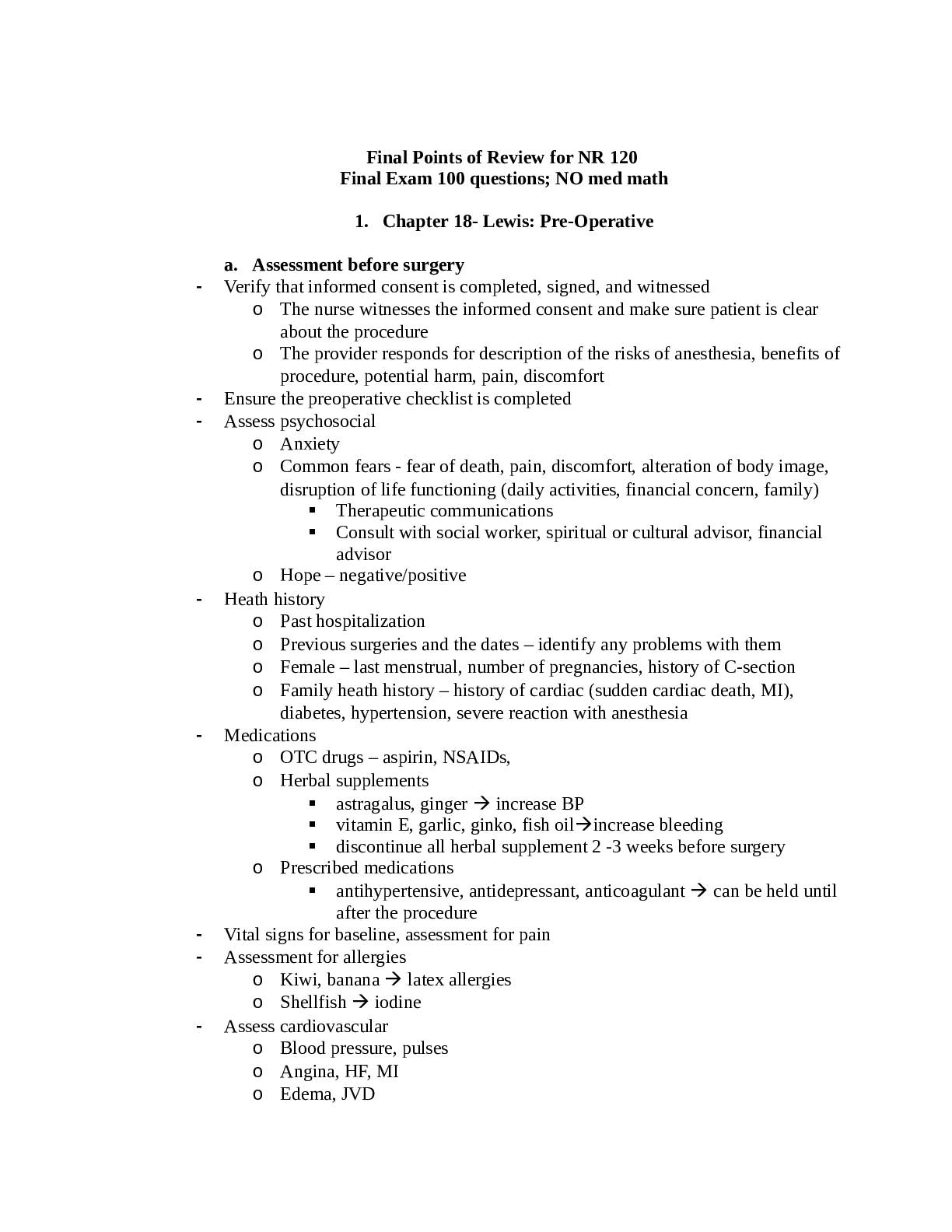
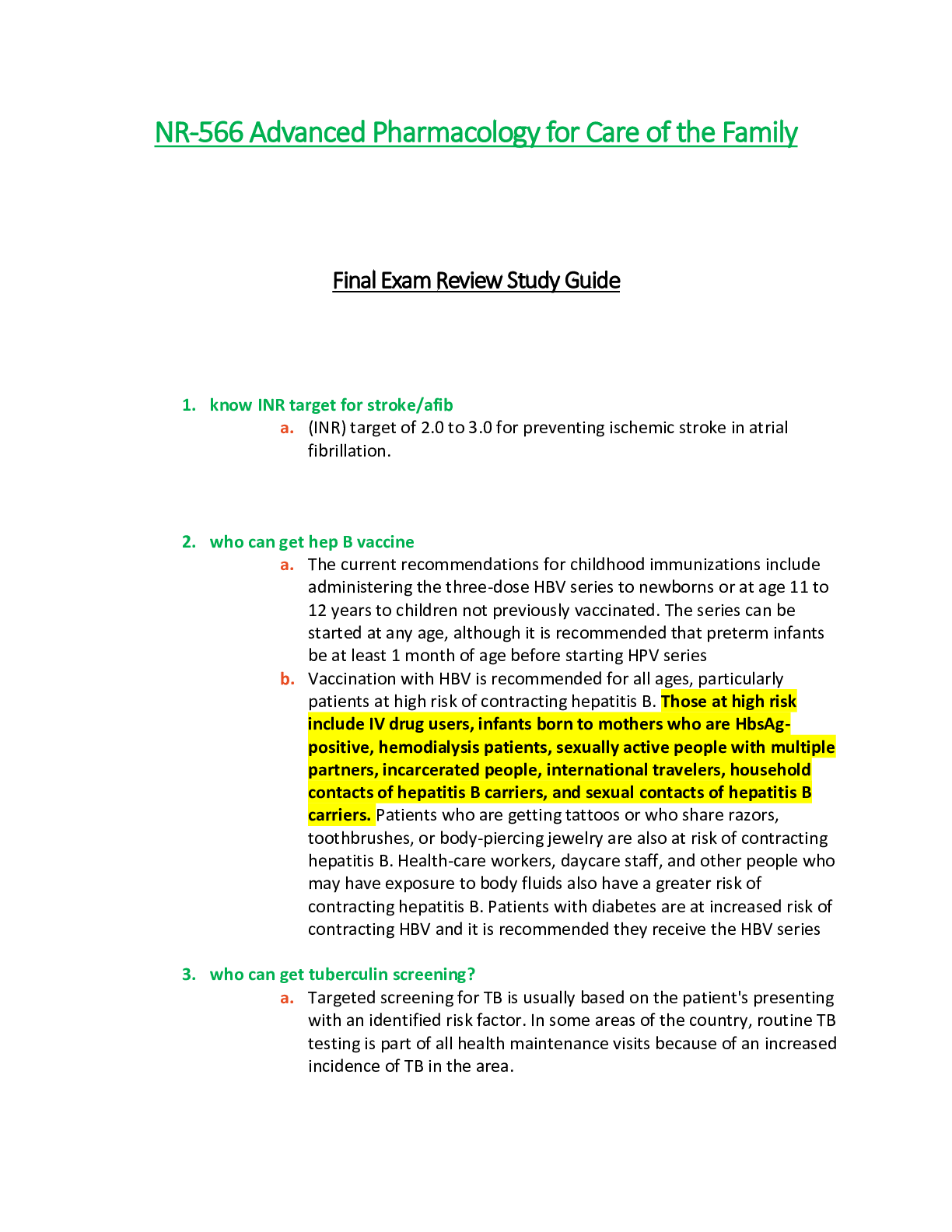
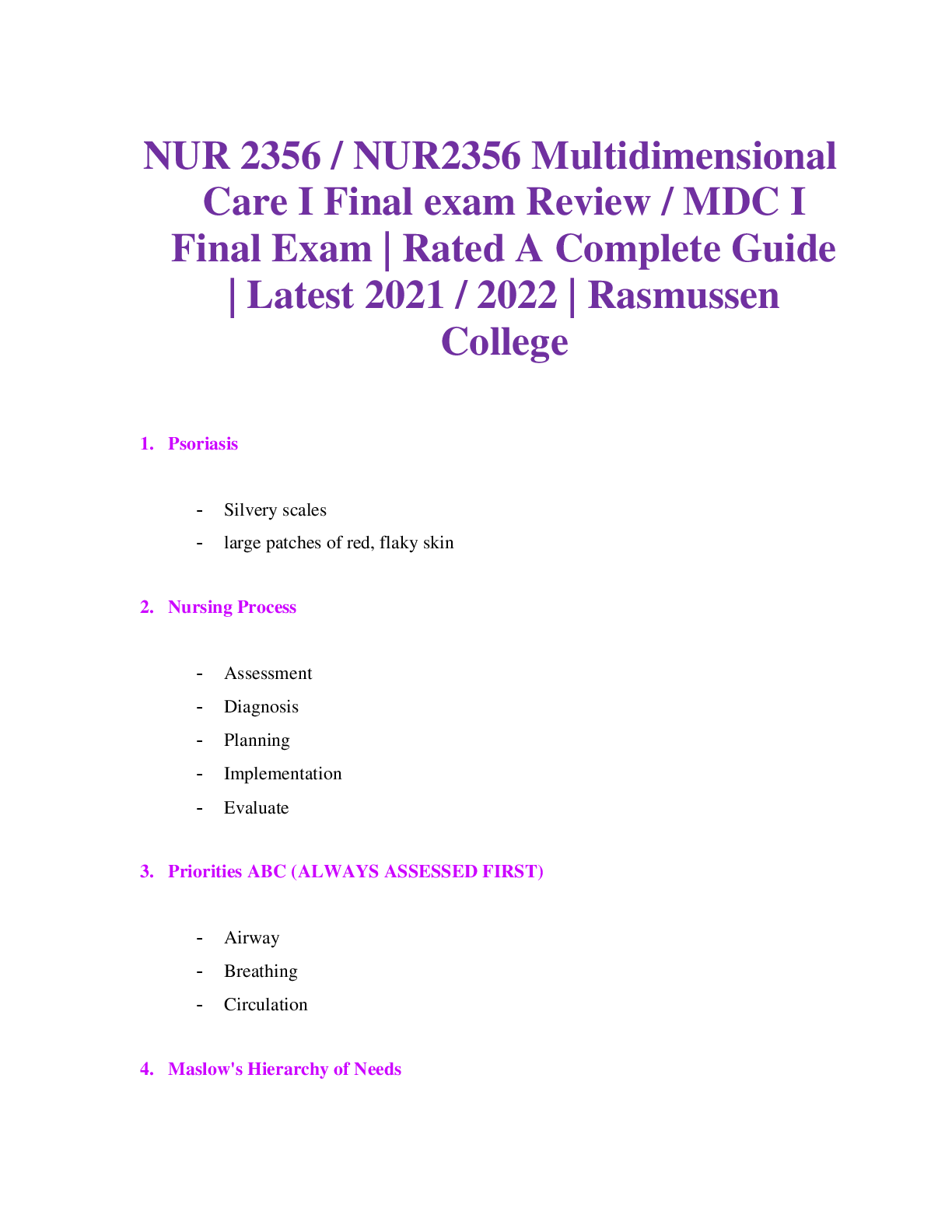
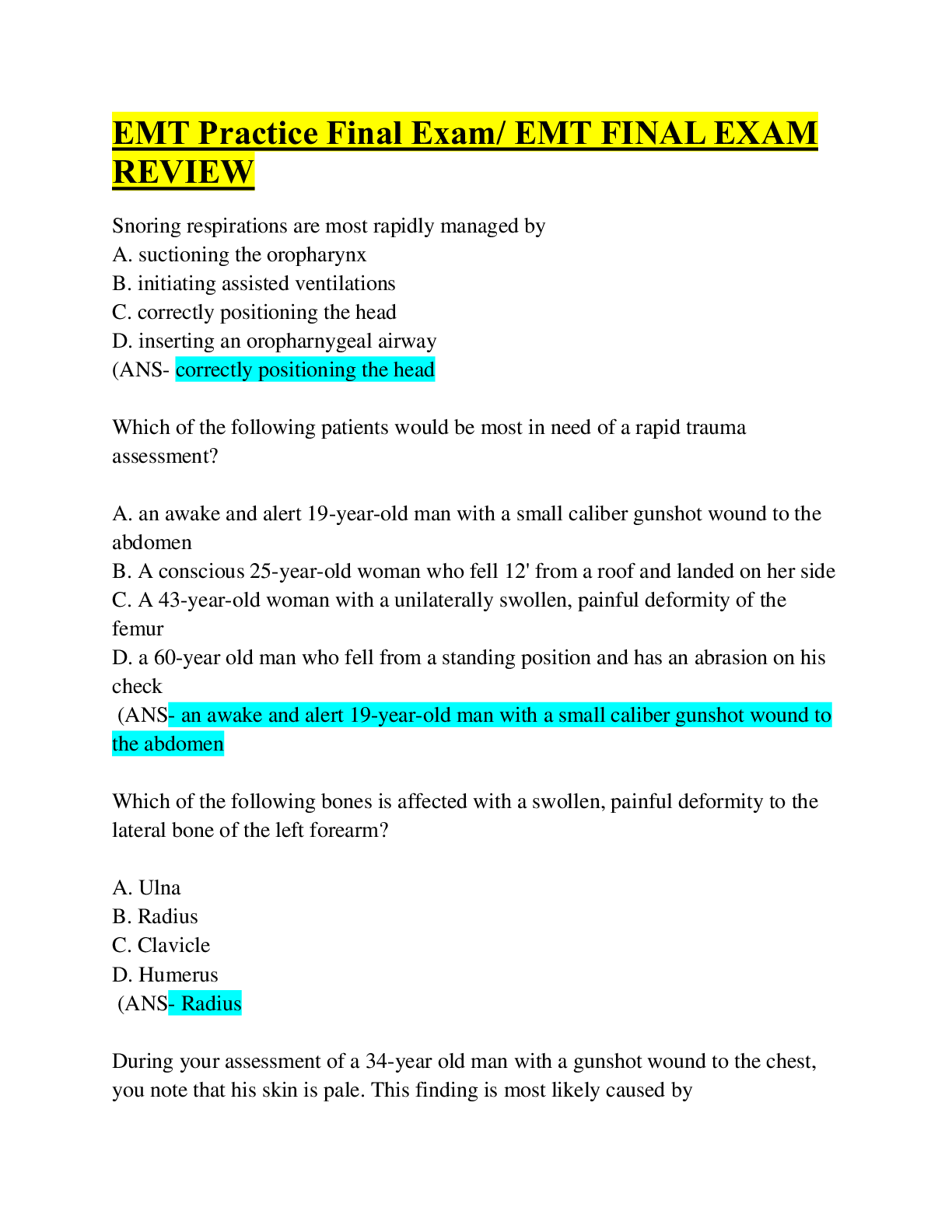

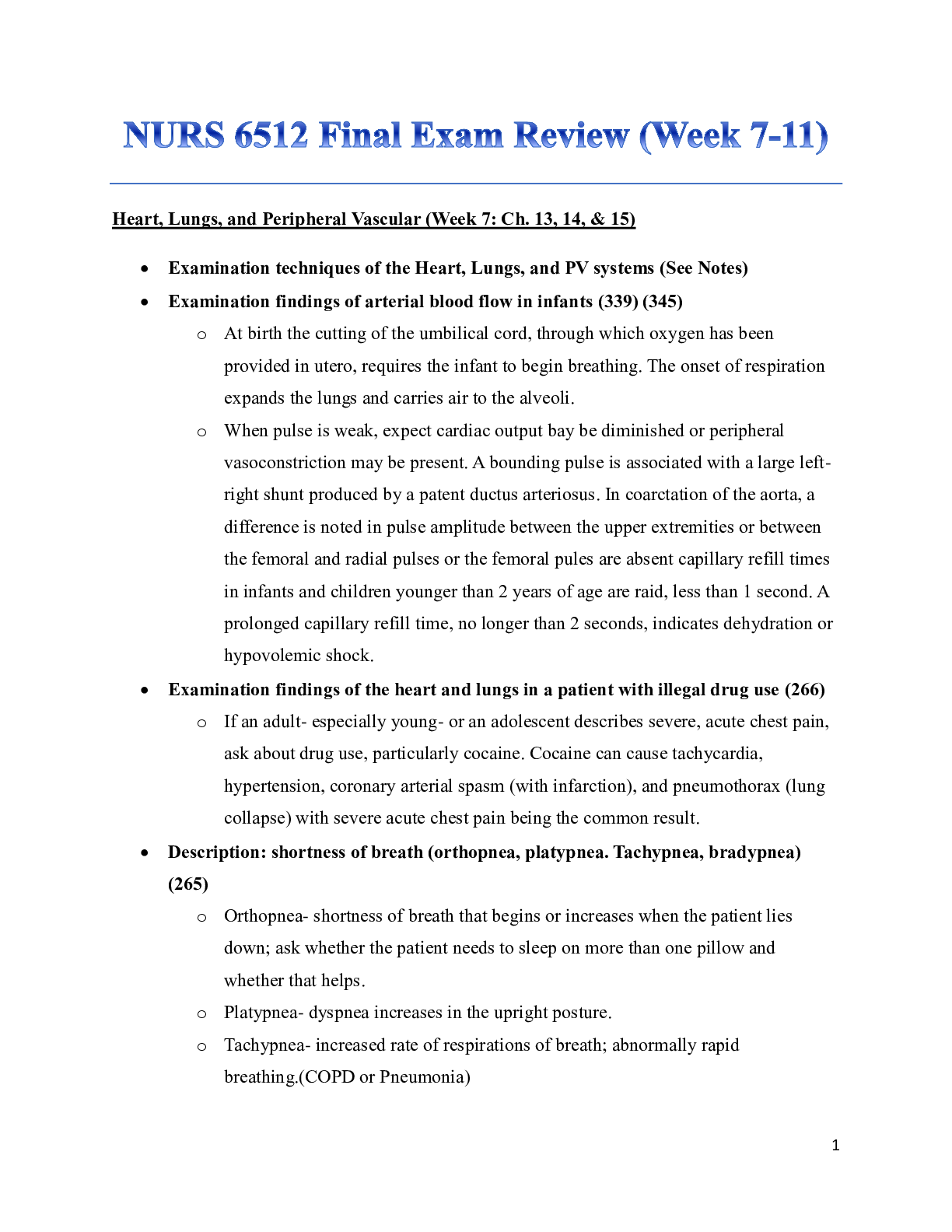

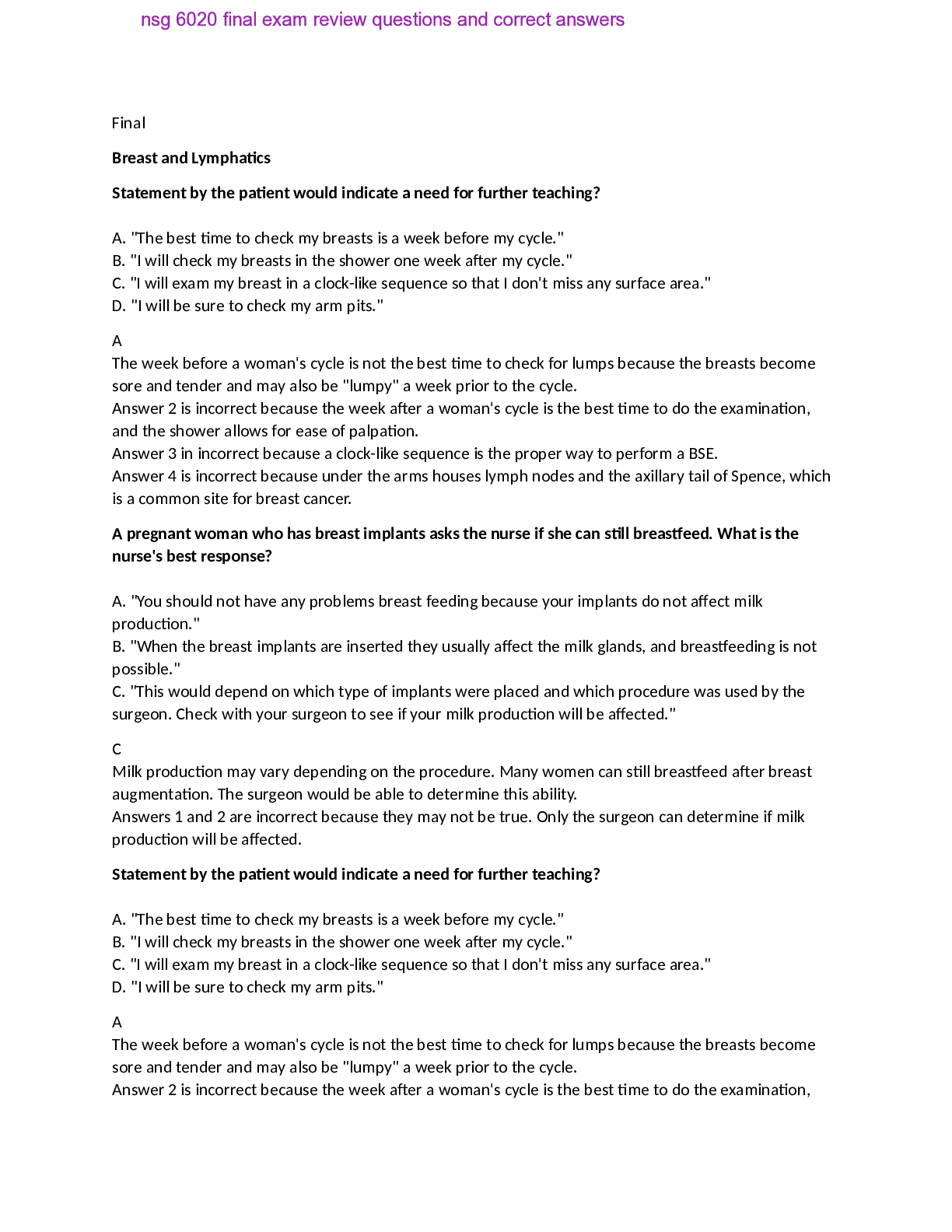

.png)
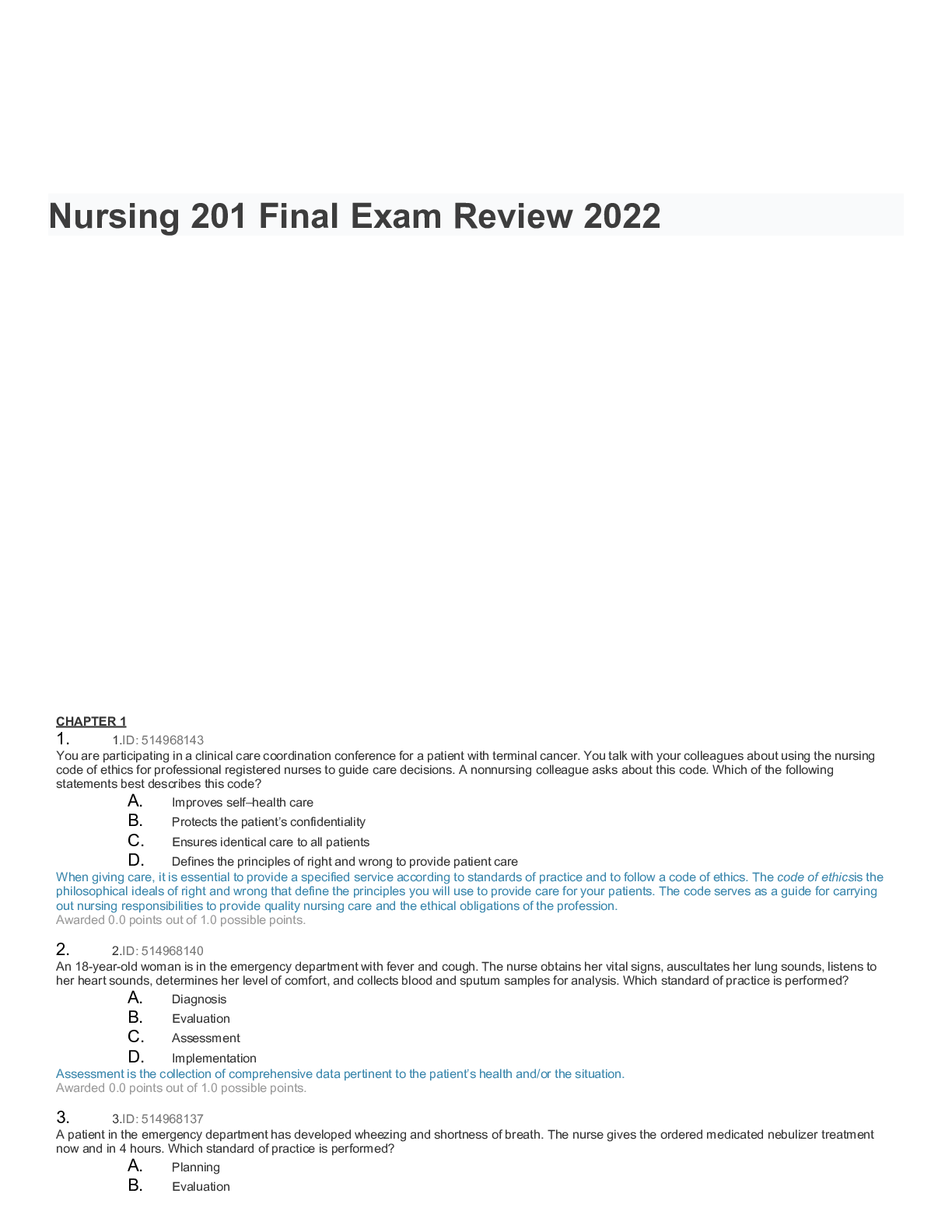
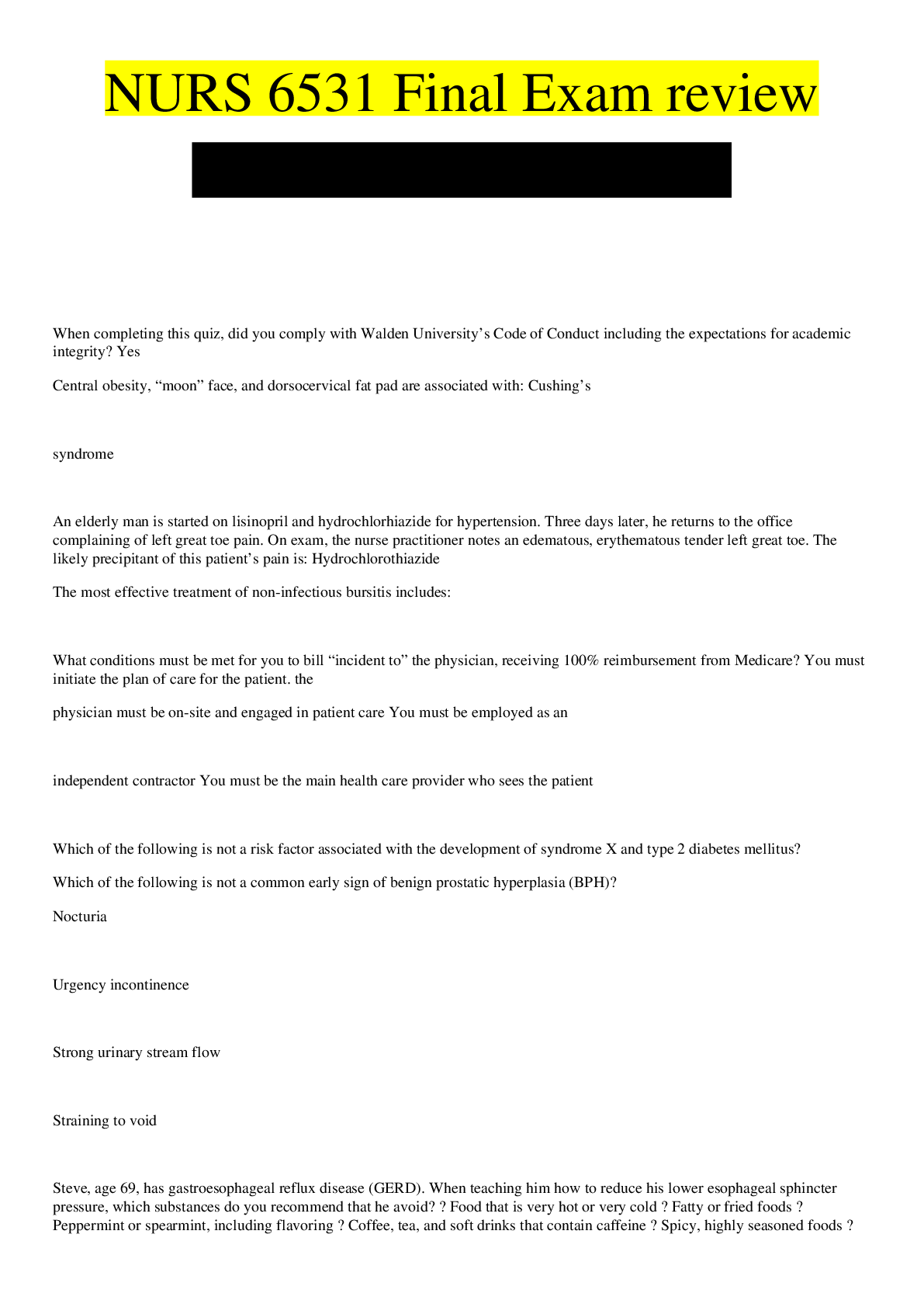
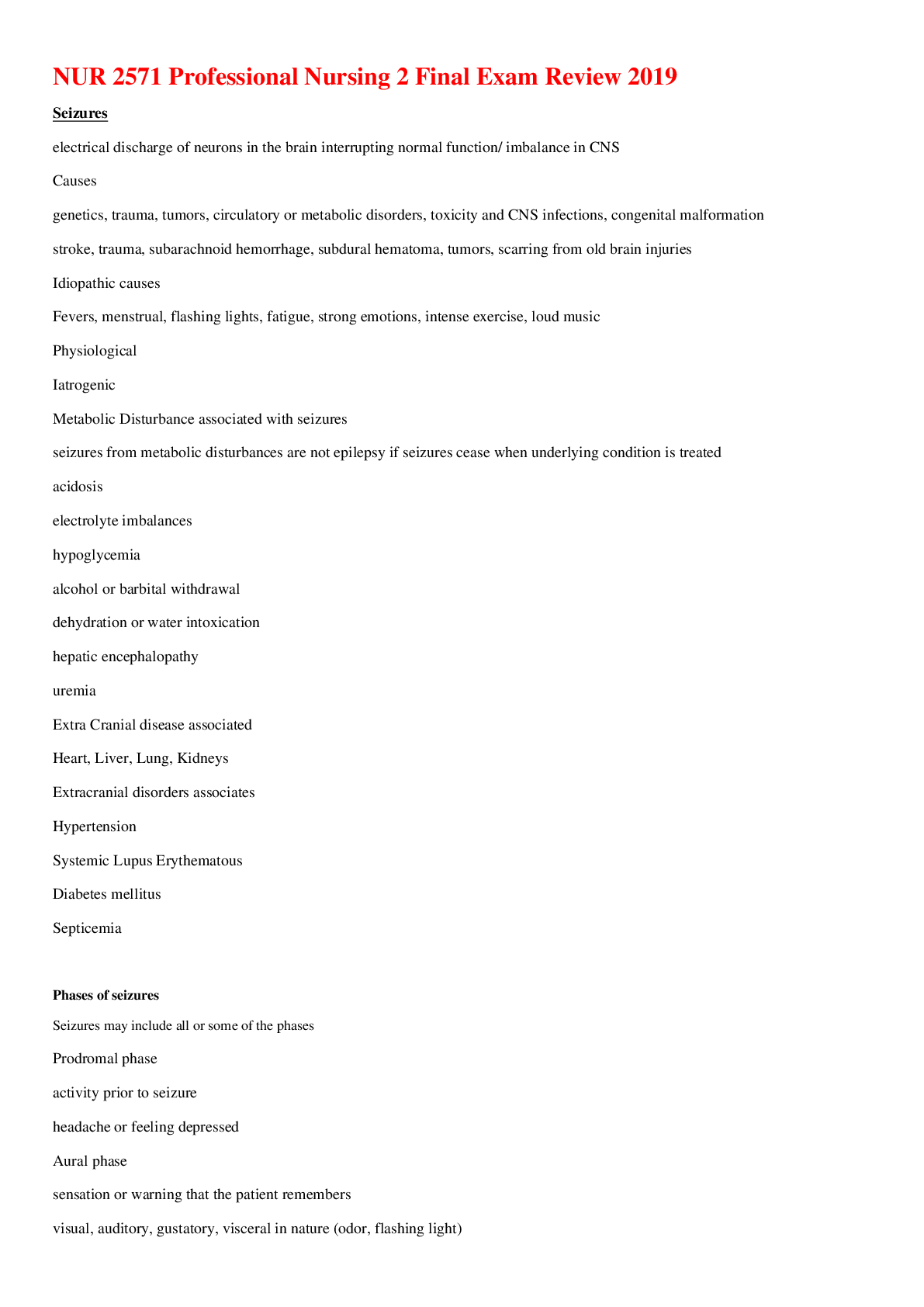

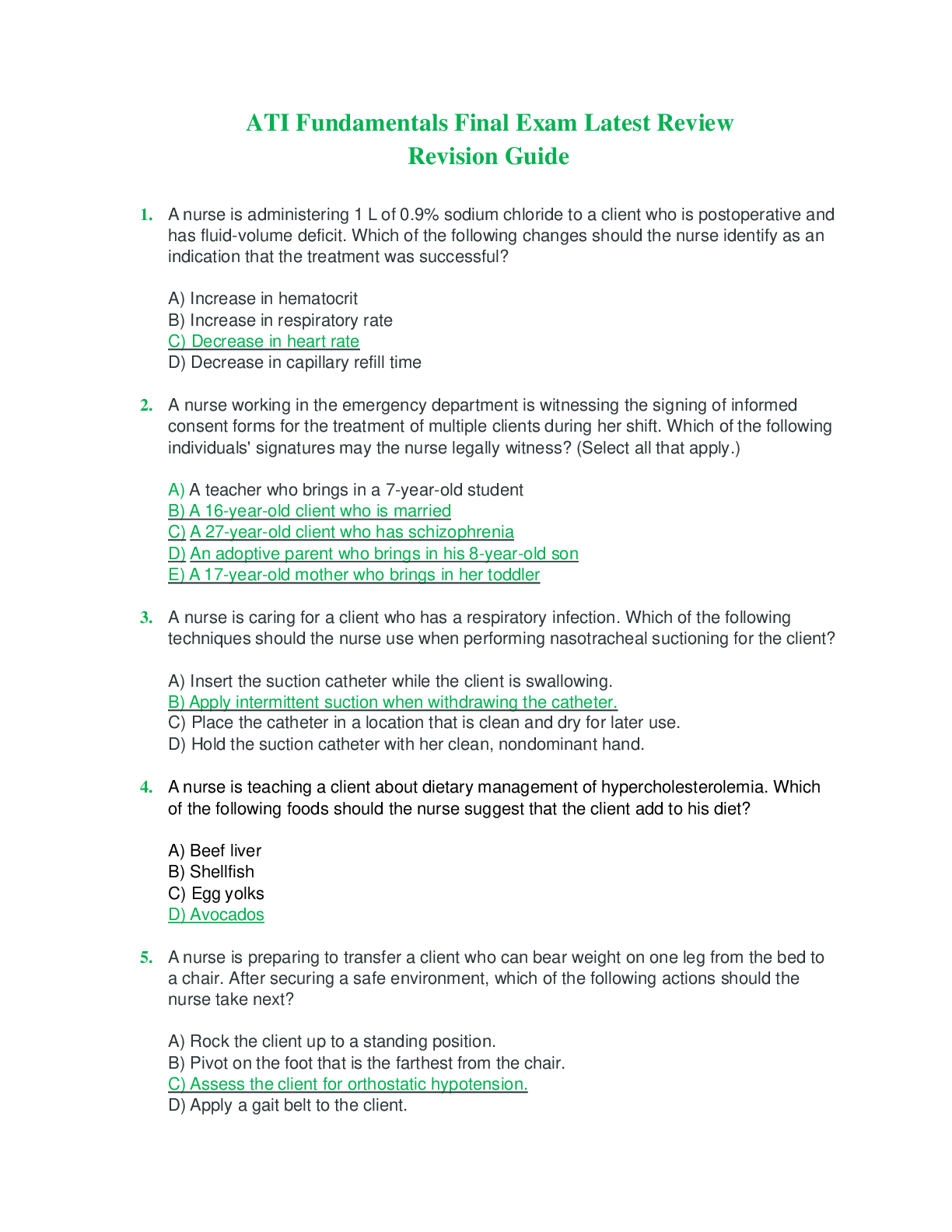
.png)
.png)
 (1).png)
 (1).png)
